DfT category A Fare zone 1 Number of platforms 6 | Station code BFR Accessible Yes Opened 10 May 1886 | |
 | ||
Similar Farringdon station, Moorgate station, Fenchurch Street railway st, Charing Cross railway st, London Waterloo station | ||
Old blackfriars station tour
Blackfriars, also known as London Blackfriars, is a central London railway station and connected London Underground station located in the City of London. Its platforms span the River Thames, occupying the length of Blackfriars Railway Bridge, a short distance downstream from Blackfriars Bridge. Since 2011 there have been station buildings, with passenger entrances, on both sides of the river; the north bank entrance is on the south side of Queen Victoria Street and the south bank entrance, opened in 2011, is adjacent to Blackfriars Road. It is the only London station to span the Thames, with entrances on both banks.
Contents
- Old blackfriars station tour
- Main line railway station
- Southern Railway and Southern Region
- Underground station
- Station rebuild
- Accidents and incidents
- Services
- Connections
- References
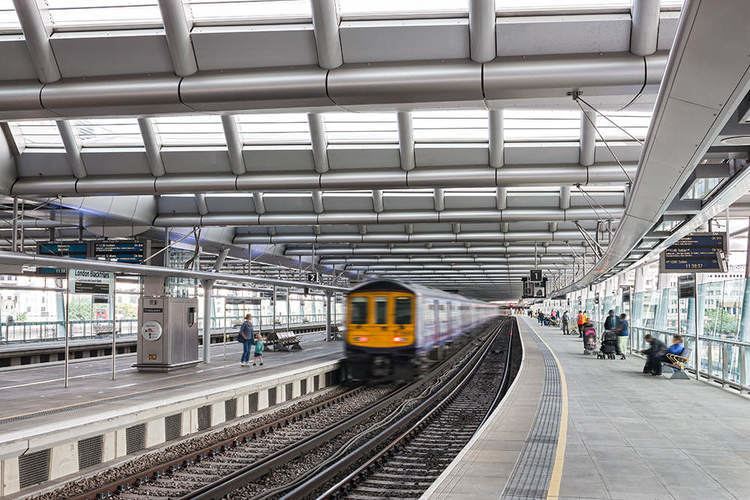
The main line station was opened by the London, Chatham and Dover Railway company with the name St. Paul's in 1886. The Underground station opened in 1870 with the arrival of the Metropolitan District Railway. The station was renamed Blackfriars in 1937. National Rail services are now provided by Southeastern and Thameslink while the Underground station is now served by both the District line and, since 1949, the Circle line. The Underground station was closed for renovation work for nearly three years between 2009 and 2012. The station falls within fare zone 1.
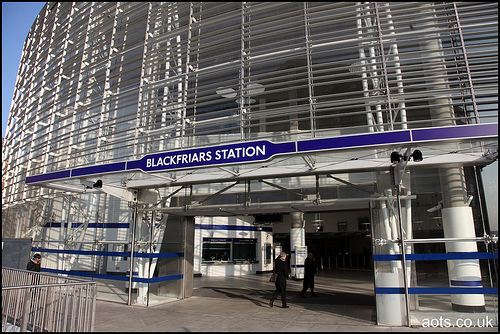
Main line railway station
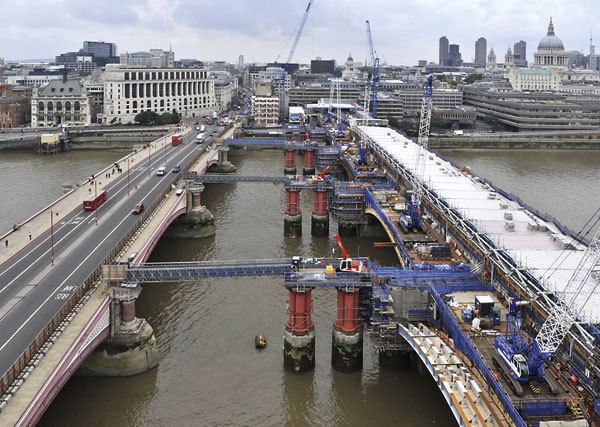
St. Paul's railway station was opened by the London, Chatham and Dover Railway (LC&DR) on 10 May 1886 when the company opened the St. Paul's Railway Bridge across the River Thames. The bridge was constructed parallel to the LC&DR's existing Blackfriars Railway Bridge, which had opened on 21 December 1864 and served to carry trains on the LC&DR's busy City Line from south London into the LC&DR stations at Ludgate Hill, Holborn Viaduct and, via the Snow Hill tunnel and a connection to the Metropolitan Railway near Farringdon, on to King's Cross and St Pancras stations.
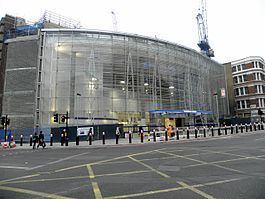
After the opening of St. Paul's station, an earlier LC&DR station on the south side of the river, called Blackfriars Bridge station, which had opened in 1864, was closed to passengers but remained as a goods station until 1964. The station has since been demolished but the entrance driveway remains. Further down Blackfriars Road is the entrance to an earlier station called Blackfriars Road station which operated from 1864 to 1868 as part of the competing South Eastern Railway. The bricked-up entrance and preserved engraved station name can be seen under the bridge carrying the railway between London Bridge and Waterloo East over Blackfriars Road. At track level the space occupied by the platforms can be seen.
Southern Railway and Southern Region

St. Paul's station was renamed by the Southern Railway as Blackfriars on 1 February 1937, to avoid confusion with the recently renamed St Paul's tube station on the Central line of the London Underground. It suffered significant bomb damage during the Second World War but was repaired. After the creation of British Railways following the war, the station was managed by British Railways (Southern Region). Gradually, the structure of the original Blackfriars Railway Bridge deteriorated until it was unsound. The bridge deck was removed in 1985 and only the piers in the river and the orange bridge abutments remain.
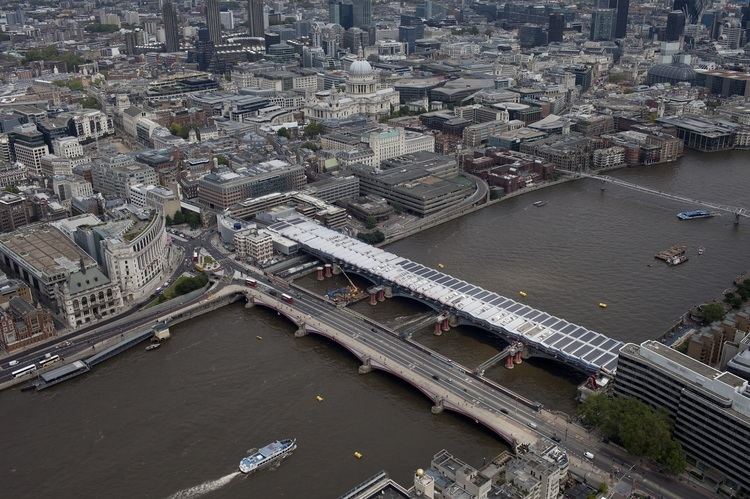
The station was rebuilt along with the Underground station between 1973 and 1977 and was formally reopened on 30 November 1977. A part of the stonework elevation from the 1886 LC&DR station has been preserved at platform level in the main line station indicating many destinations in the south-east of England and in Europe. St. Paul's Bridge is now known as Blackfriars Railway Bridge.
Underground station
Blackfriars Underground station is served by the Circle and District lines and is between Temple and Mansion House stations.
The station was opened on 30 May 1870 by the Metropolitan District Railway (MDR) as the railway's new eastern terminus when the line was extended from Westminster. The construction of the new section of the MDR was planned in conjunction with the building of the Victoria Embankment and was achieved by the cut and cover method of roofing over a shallow trench.
On 3 July 1871 the MDR was extended eastwards to a new terminus at Mansion House.
It was closed on 2 March 2009 for major renovation work and reopened on 20 February 2012.
Station rebuild
Blackfriars station was significantly renovated between 2009 and 2012, with the terminal platforms at the station being closed from 20 March 2009. The office building above was demolished and replaced as part of the Thameslink programme. The new station is the same height and houses a shared National Rail and London Underground ticket hall and ventilation shaft together with escalators and lifts between a mezzanine level for main line railway services and the sub-surface level for London Underground services. The Underground station also received major enhancements, with a new roof of glazed north lights and partial-height glazed side panels installed along the entire length of the bridge.
On the south bank of the river a new station entrance was built at Bankside, containing a second ticket hall. The through platforms were moved to the east side and extended along Blackfriars Railway Bridge over the River Thames to accommodate 12-carriage trains (in place of the previous eight). The layout has been altered by building new bay platforms on the west side, avoiding the need for through trains between City Thameslink and London Bridge crossing the paths of terminating ones.
The works exploited the disused piers west of the existing railway bridge which once supported the former West Blackfriars and St. Paul's Railway Bridge. The easternmost line of disused piers was strengthened, tied into the existing bridge and clad in stone. The number of bay platforms was reduced from three to two in the process, but some terminating services have now become through services, and the increased length allows longer trains to terminate at Blackfriars. The subway entrance to Blackfriars station has been permanently closed.
The original concept for the project was designed by Pascall+Watson architects, with execution by Jacobs and Tony Gee and Partners; it was built by Balfour Beatty. By January 2011 the eastern half of the station's new roof had been erected and Thameslink services began using the newly constructed platforms on the east side of the bridge, where the bay platforms used to be. On the western side of the station the original eight-carriage platforms were removed and the bridge deck widened to provide space for the new terminus platforms. The station's new entrance and ticket hall on the south side of the river opened on 5 December 2011.
The Waterloo & City line, a deep-level tube line which runs non-stop between Waterloo and Bank, runs almost directly under Blackfriars station and there have been suggestions to construct an interchange station for the line at Blackfriars. The Department for Transport considers this to have "no significant transport benefit".
In January 2014 the Blackfriars Railway Bridge became the world's largest solar-powered bridge having been covered with 4,400 photovoltaic panels providing up to half of the energy for the station.
Accidents and incidents
Services
Blackfriars main-line station is served by through services on the Thameslink route operated by Thameslink and Southeastern. This includes trains from Bedford, St Albans City and Luton to the north, and Brighton, Sutton and Sevenoaks to the south. Southbound trains run via London Bridge or Elephant & Castle; northbound trains next call at City Thameslink. Before March 2009 some services from the south terminated at three bay platforms, which were then removed during renovation works. Two new bay platforms opened in May 2012 and are used during peak hours and at weekends. Southeastern provides direct services to Kent during the Peak (Monday to Friday).
The typical Monday to Friday off-peak service is as follows:
The Saturday service is as follows:
The Sunday service is as follows:
After midnight, on all days, an hourly service runs between Bedford and Three Bridges.
The Underground station is served by the District and Circle lines and is between Temple to the west and Mansion House to the east. It is in fare zone 1.
Connections
London Buses routes 45, 63, 100, 388 and night routes N63, N89 and N550 serve the station.
